|
One of the most popular post-graduation career options for public relations majors is to join an agency. Agencies are exciting, fast-paced places to work, and I can say from experience you will learn a lot and quickly during your agency experience. I was attracted to agency life due to the variety of opportunities it offers, including the ability to work on multiple clients and grow quickly as a professional.
However, the popularity of these positions means they can be incredibly competitive. Don't let that intimidate you though! As a member of the Illinois State University Chapter of the Public Relations Student Society of America, you're already a step ahead. Here are some tips to landing that coveted agency internship: First, know that you will have to intern before you are hired. That's just the reality of agency life. There are exceptions to this rule, but they are just that‒exceptions. Internships are the best way to break into the agency world, and they allow you to discover if agency life really is a fit for you. Of course, in order to land the internship, you have to apply for it, and one part of the application process that many students dread is the interview. These are a few tips and tricks I've picked up as both an applicant and an employee: • Do your research: both on the agency and, if you can, on your interviewers. Know why you want to work at that particular agency, and be able to speak about its clients and recent work. • Practice answering common interview questions beforehand. Always prepare for questions relating to your education and experience. • Ask questions! I believe that it's a huge negative to not ask questions at the end of an interview. Prepare some questions ahead of time so you are ready to go. Also, if you have multiple interviewers, it's okay to ask the same question more than once. They won't know you did, and you can hear how different people answer. If the interview goes well, most agencies will send you a writing test. Some agencies allow you to complete these on your own time, while others require you to return to the office; it all depends on the agency. Many students (myself included) share their writing test experiences with Dr. Smudde, so he is a wonderful resource for writing test Advice. For all writing tests, familiarity with basic grammar and AP style is key. Writing tests are also an opportunity to demonstrate creative thinking, your research abilities, and your knowledge of the public relations industry. Hopefully, after all of that, you were able to successfully land an internship. Agencies are exciting places to start your public relations career. Some of the best advice I heard was to treat my internship like a three-month long interview. Additionally, speak up if you want to be hired full-time! While a lot of hiring is based on timing and staffing needs, you will never get hired if human resources does not know you are interested. I met with human resources halfway through my internship to express my interest, and interns who did not get hired right away have successfully kept in touch via email and been hired later. If it truly is a fit, it will probably work out. That's a lot of information for one blog post, and there are definitely more ins and outs to the application process I can share; please feel free to ask questions in the comments below! By Abby Brennan
0 Comments
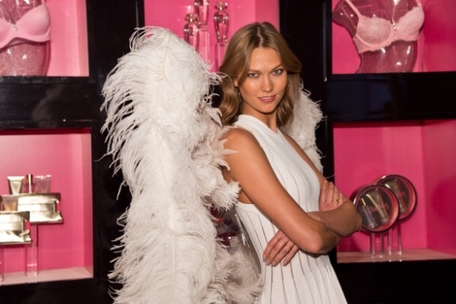 It is no longer a secret: Karlie Kloss is leaving Victoria’s Secret. The 22-year-old supermodel removed her wings to land at New York University. “It’s something I’ve always wanted to do,” said Kloss in reference to attending the university. She does plan to continue modeling, however, just not as much. Kloss, known for her association with Victoria’s Secret, first appeared on the runway for the brand in 2011 during the annual Victoria’s Secret Fashion Show. Since then, her involvement with the lingerie brand has soared into many other deals, including a contract she signed in 2013 making her a Victoria’s Secret Angel. By ending her contract with Victoria’s Secret, Kloss has impacted her personal brand. Our personal brand is what sets us apart from our colleagues and can give us a competitive edge. Future employers can see our personal brands by looking at our portfolios and even our LinkedIn profiles. For models, personal branding includes what shows the model has walked in, what editorials the model has done, and her personal street style. Kloss’s personal brand includes her contracts with companies like L’Oreal Paris, Kate Spade, and her appearance on the cover of Vogue. One of her well-known personal brands includes her bob cut affectionately nicknamed the “Karlie Cut.” Every aspect of our life makes our brand, and our brand constantly evolves. By ending her contract with Victoria’s Secret, Kloss’ brand will change. Her brand will now include a college education. Public relations students can learn from Kloss. By gaining new experiences, like an internship, public relations students can further develop their brand. Professionals have a brand. Every aspect of our life involves our brand and our brand constantly evolves. In my opinion, Kloss is making a great decision that will positively influence her brand. By Tyler Krivich 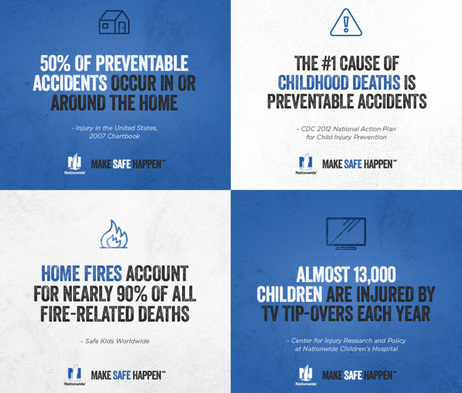 Viewers from all over the country tuned in to watch the Super Bowl XLIX on Feb. 1. In fact, according to Nielsen Ratings, it reached an audience of nearly 115 million people. Twitter stated that there were an estimated 28.4 million tweets posted about the game, and Facebook saw nearly 70 million people converse about it as well. Clearly, the companies that paid millions for their spots during the game received their money’s worth and then some. Nationwide was one such company that paid millions to run its spot. Nationwide’s “Make Safe Happen” commercial stars a young boy who discusses things he will never be able to do—like learn to ride a bike, get “cooties,” or travel the world—because he died. The commercial cuts to various accidents in the home, like a TV that has fallen over, or an overflowing bathtub. We then learn that preventable accidents in the home are the number one cause of death for children in the U.S. Reaction to the commercial was instantaneous, generating more than 300,000 tweets, according to Twitter. Many viewers expressed outrage that such a “buzzkill” of a commercial was aired during what many consider to be a family event. Viewers’ complaints ranged from the pain of having to watch the commercial alongside their children, to how it stood in stark contrast to other commercials, such as Microsoft’s ad that portrayed children as remarkable. Nationwide responded the same day with a press release stating that it knew the ad would “spur a variety of reactions.” Nationwide has worked for 60 years to educate the public on how to prevent accidents in the home from happening. Adam Tucker, president of Ogilvy & Mather Advertising (the agency that created the ad for Nationwide), felt that this ad could shake things up enough to capture attention and raise awareness of at-home accidents. “In 60 seconds, we can probably bring more attention, awareness, and action around this issue than we have in 60 years,” said Tucker at an executive meeting where CNN was present. The ad certainly achieved the goal of grabbing attention and raising awareness of at-home accidents. Hundreds of thousands tweeted about the ad, effectively starting the conversation for Nationwide. In Nationwide’s press release, the company also stated that thousands of people visited MakeSafeHappen.com, the website Nationwide touts in the commercial, after the spot aired on TV. Among the 300,000 tweets viewers sent out, some positive feedback was reported. Some viewers even thanked Nationwide for bringing a tough issue out into the open rather than brushing it under the rug. “We wanted to stage an intervention and start a conversation,” said Matt Jauchius, chief marketing officer for Nationwide, in an interview with NPR. “If we save one child as a result of what we did in the Super Bowl, it is more than worth it.” It is important to realize that although running this spot generated conversation about preventable accidents, Nationwide still took a huge risk in airing the commercial because of its startling content. The lasting impact of this commercial on Nationwide’s reputation is something that will need to be continually monitored by public relations, marketing, and crisis teams within the organization. Nationwide will need to keep an eye on public perception and the conversation that ensues on both social and traditional media in the months to come. By Miranda Pietschman 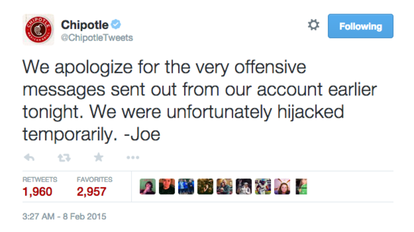 Tackling the issue of hacked social media accounts and privacy loss is something all public relations professionals should learn how to do. The hacking of celebrity and high-profile organizations’ social media accounts is not a rare occurrence. On Sunday, Feb. 8, Chipotle’s Twitter account fell victim to one of these hacks. A profile picture change from the business logo to a swastika was not the only offense. The tweets that made it onto Chipotle’s platform were even more offensive. In response to the situation, Chipotle’s new media manager, Joe Stupp, sent out an apology after regaining control of the account. Chipotle was quick to respond and apologized on multiple platforms. As of now, Chipotle is investigating the problem to determine who was involved. Chipotle’s Twitter is not the only high profile social media account that has been hacked this year. Taylor Swift’s Instagram and Twitter account was hacked at the end of January. Tweets were sent out from her personal account (which have been deleted) to her 51 million followers. In these tweets, two accounts received shout-outs. It has been suggested that these accounts are notorious hackers. Swift reported the hack on her blog and is having Twitter investigate what happened. Since public relations professionals use social media for branding and communicating purposes, they must remember the risks associated with it. Chipotle’s media manager set an excellent example of effective crisis communication in the wake of its Twitter account being hacked. Stupp quickly distanced Chipotle’s brand from the offensive tweets and apologized. As Stupp and Swift showed, dealing with the effects of being hacked in a timely manner is paramount to a recovery. By Cindy Kirchner 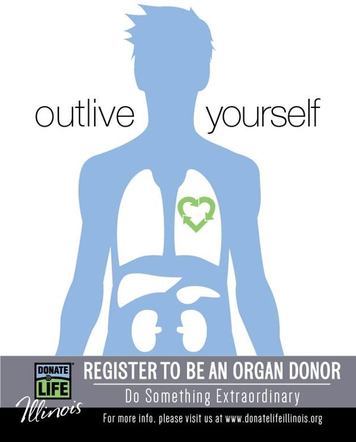 This year, the Illinois State University Chapter of the Public Relations Student Society of America is offering a new opportunity for its members. The Chapter is partnering with Gift of Hope Organ & Tissue Donor Network to host an event in April designed to raise education and awareness on organ and tissue donation. While attending PRSSA National Conference in Washington, I connected with the Gift of Hope, a member of the organization Donate Life Illinois. Donate Life Illinois is part of an alliance of organizations responsible for organ, tissue, eye, blood, and marrow donation, as well as donor education and registration in Illinois. As a part of the Donate Life America coalition, Donate Life Illinois is one of 45 regional coalitions and 50 national businesses/associations working to raise awareness, education, and donor numbers. Donate Life Illinois has various member organizations beneath it, including Gift of Hope Organ and Tissue Donor Network. This nonprofit is one of 50 organ procurement organizations that make up the nation’s donation system. It coordinates organ and tissue donation and provides public education on donation in Illinois and northwest Indiana. It works with 180 hospitals, serving 12 million people in its donation area. In its 29 years, Gift of Hope has saved the lives of more than 18,000 organ transplant recipients and improved the lives of hundreds of thousands through tissue transplants. After the Conference, I returned to ISU with one goal in mind: to bring Gift of Hope to ISU’s campus. Ten months ago, in the midst of tragedy, Gift of Hope brought light to a hurting community and family. If you are not familiar with the Michael Collins foundation, I encourage you to explore the website. A drunk driver tragically killed Collins, a senior at ISU, in April last year. Because Collins was an organ donor, his organs, eyes, and tissue impacted and saved 200 lives. His mother, Kelly, is able to share that Collins’ gift restored a blind woman’s sight in New York. Not only does this organization benefit people across the world, but it has made a huge impact right here in the Bloomington-Normal community. For those receiving a donation, it is potentially lifesaving. For those who are donors, you are giving the most selfless and valued gift of all – the gift of life. And the Gift of Hope is just that, hope for a future for so many. There are currently 5,186 people waiting for a lifesaving organ transplant in Illinois. The Rowan University Chapter of PRSSA has formed a competition between schools to participate in the National Organ Donor Awareness Competition. This competition will fuel the planning of an event at ISU that will focus on educating students, raising awareness, and generating conversation about organ donation, all while taking in new donor registrants. A team of ISU PRSSA members will partner with Gift of Hope representatives and potentially other community and faculty sponsors to complete the day event. The PRSSA members will then compile a portfolio of their efforts, including research, strategic plans, budget, invitations, news releases, and a media kit. The portfolio will be sent to Rowan University PRSSA, and the winners will be announced at the Conference this fall. Grand prizes will be awarded to the top three Chapters. This competition is not only a great opportunity to gain experience, but also, more importantly, to make a difference. By Ali Seys On Jan. 7, fans of music artist Sia stopped swinging from their chandeliers and witnessed another Sia masterpiece posted on her VEVO YouTube channel. The music video was for her new song, “Elastic Heart,” and features young dancing prodigy Maddie Ziegler along with an unexpected partner: Shia LaBeouf.
In the video, the dancers are together in a giant cage and use modern dance technique to display a battle. Ziegler sports the same costume she wore in the video for “Chandelier,” with LaBeouf wearing the male equivalent to her nude leotard. The costumes were dirty and smudged, adding to the battle theme. Given the outstanding feedback Sia’s “Chandelier” video received, it was expected that “Elastic Heart” would receive the same feedback, especially since Ziegler was featured in the music video. However, the new music video did not receive the same response. Because of the large age difference between Ziegler and LaBeouf, many fans thought the video was verging on pedophilia. The choreography of the dance was heavily influenced by modern dance technique and style, which fans witnessed before in “Chandelier” as well as during live performances of the song. Yet for some fans, these movements have taken on a different meaning. To clear up the confusion, Sia reached out to her fans and apologized for the misconception. Sia’s apology did not isolate the fans who misunderstood the music video but let them into her thoughts as she explained what she was trying to showcase. Sia used Twitter to express her thoughts to her fans by saying, “I apologize to those who feel triggered by #ElasticHeart. My intention was to create some emotional content, not to upset anybody.” In two prior tweets she said, “I anticipated some ‘pedophilia!!!’ cries for this video. All I can say is that Maddie and Shia are two of the only actors I felt could play these two warring ‘Sia’ self-states.” By taking to Twitter, Sia was able to address the possible crisis at hand with a majority of her fans and nip it in the bud. Sia has always been open about her brand, even going as far as to explaining why she chooses not to show her face on camera, and this latest action on Twitter only reinforces that brand. In the article, “My Anti-Fame Manifesto,” Sia wrote for Billboard in 2013, she refers to society and its opinions as, “a stereotypical, highly opinionated, completely uninformed mother-in-law.” She then continues, saying, “I've never been very famous, but I've worked with a lot of famous people, and I've seen a lot of their mothers-in-law. And I can tell from what I've seen that I don't want one of my own.” By clearing up the confusion with her music video, Sia was able to defend her intention for “Elastic Heart” while still appearing sensitive to the concerns of her fans. In this way, she has effectively minimized the likelihood of a crisis happening to her brand as a result of viewers’ misinterpretation of the video. By Chloe Kasper The little blue box is jewelry icon Tiffany’s classic representation of love and affection. The timeless design has been intertwined into many love stories, and with the organization’s latest campaign, many more to come. Recently, Tiffany & Co. launched a new ad campaign for engagement rings called, “Will You,” which features a love story previously untouched. It follows a homosexual couple, making Tiffany & Co. the first major jewelry brand to do so. And, according to ELLE.com, the men pictured are an actual couple living in New York City.
By taking this leap into a new kind of love story, Tiffany & Co. is taking a big step, but will the change be beneficial? For years, they have not included homosexual couples in their ads and have been successful, so what will happen now that the change has been made? According to Linda Buckley, Tiffany’s vice president of North American public relations, the change is beneficial, saying in a statement to ELLE.com, “Nowadays, the road to marriage is no longer linear, and true love can happen more than once with love stories coming in a variety of forms.” Now that the change has been made, Tiffany’s has opened up its brand to a whole new audience that loves the designs just as much as anyone else. This monumental step is also making waves outside of Tiffany & Co. The lesbian, gay, bisexual, transgender, and queer (LGBTQ) community is still underrepresented in pop culture, especially in advertising. This ad allows LGBTQ couples to see themselves represented in the new form of Tiffany’s brand, which will have a major impact on the LGBTQ community's continued involvement with the company. Tiffany & Co.’s ads in the past have depicted ideal images of love in settings that seem too good to be true. With this ad, however, that is not the case. The men pictured are a real couple and their actions in the ads are not just poses for the camera. By having this knowledge, consumers can filter through other ads and come to this one knowing it carries authenticity. Their real life romance makes the scene more relatable and ultimately more attractive to a widespread audience. Overall, with both of these changes, we will see many more little blue boxes in the years to come. By Chloe Kasper 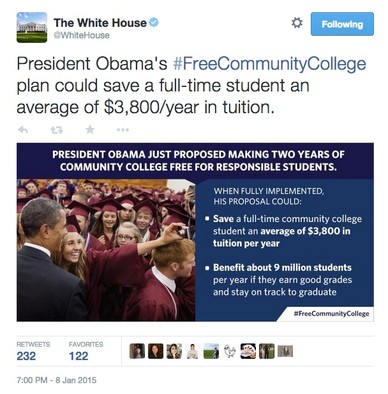 Two weeks shy of the State of the Union Address, President Obama proposed his plan for two years of tuition-free community college. The White House shared the news on Jan. 8 via Facebook in a two minute video along with the hashtag, #FreeCommunityCollege. The video features an airborne President Obama outlining the framework for his proposal while flying to Tennessee on Air Force One to deliver a speech about the proposal. The announcement has received mixed reviews from proponents and critics alike and is generating quite a buzz among the nation; or at least the nearly 8 million people who viewed, shared, and liked the video on Facebook. Assuming that the proposal makes it past Congress, the plan, which has been dubbed America’s College Promise, could potentially help an estimated 9 million students. Under the proposed plan, students would have to maintain a GPA of at least 2.5 in addition to being enrolled in school at least half-time. The details of the framework have yet to be released; however, President Obama is promising, “two years of free community college for anyone who’s willing to work for it.” Social media is a much used strategy in the field of public relations to brand messages that appeal to a specific audience by focusing on what is said and how it is said. Obama is no stranger to utilizing digital tools as a platform to gain supporters. Since his election in 2008, he has been noted for being one of the only presidents to use social media as an engine to drive his presidency. President Obama was very strategic in choosing to whom to market his message. Posting the announcement to Facebook as well as including a hashtag pulls in a younger demographic, one which includes the very students who will be affected by the plan he is proposing. Some Americans are wondering whether or not this promise is feasible. Because nothing is ever truly ”free,” someone will have to pay for all of this education, if not for the students. Will it be the taxpayers? Will it be more government funding leading to more government debt? Will the public support the means by which this idea could occur? One also wonders why the president decided to unfold this new campaign so late into his second presidential term. Is this tactic aimed to improve his approval rating? Most everyone can agree that student debt needs to be alleviated. Creating more opportunities for Americans to receive more education and pursue higher goals than ever before is something that many would undoubtedly support. By Deja Whitt When it comes to making history, the Illinois State University community certainly knows how to rally behind its fellow Redbirds. The ISU community, however, is spread both far and wide, making social media a key tool to spread messages to prepare for the Football Championship Subdivision game against Missouri Valley Conference rival North Dakota State University, ISU Athletics, Red Alert, and the university flagship account used social media to intensify hype surrounding the game.
Redbird fans were encouraged to use the popular hashtag, #BackTheBirds, in addition to the National Collegiate Athletic Association hashtag, #FCSChamp. These hashtags united Redbird fans’ Twitter, Facebook, and Instagram posts before and during the game. In regards to Twitter and Facebook, the ISU social media accounts consistently posted links to its website where fans could receive updates on the weekend in Frisco, Texas, as well watch party locations. Under the athletic program, videos were created to rally Redbirds wherever they may be and also included links back to the main hub with new information regarding the game. As far as sharing on social media, posts that included videos were the most popular on Twitter and Facebook. Social media was used to rally Redbird fans and generate enthusiasm for the championship game. The use of social media and the unity it created allowed Redbirds to come together, brought strength to our team, and made us all proud to be Redbirds. By Cindy Kirchner On Dec. 16, Jeb Bush announced he was exploring the possibility of running for president of the United States in 2016. Bush made his announcement on Facebook and included details on how he was starting a leadership political action committee to raise funds. The announcement caught significant attention from members of the media who analyzed his announcement.
Bush has a reputation issue; when the average American hears the name Bush, he or she probably thinks of President George W. Bush. With the housing market crash and the negative opinions on the War on Terror, President Bush left the White House in 2008 with a low approval rating hovering around 30 percent. To have a successful shot at the White House in 2016, Bush needs to rebrand himself and pull away from his brother’s image. The public may know of Bush because of his family’s role in politics, but this large recognition does not translate into a large following. Compared to tweets and statuses of other possible Republican nominees for 2016, Bush’s Facebook announcement received very little traffic. The status announcing his potential run for Republican nominee in 2016 has approximately 6,000 likes. It is estimated that if Hillary Clinton decides to run for president in 2016 and announce her decision on Facebook, she would put Bush’s social media performance to shame. Bush has approximately 120,000 likes on Facebook, while other potential republican nominees for president in 2016, such as Rand Paul and Ted Cruz, have millions. Bush’s Twitter following also trails behind potential republican candidates Paul, Cruz, and Chris Christie. Bush’s challenge will be to generate more conversation about himself, but not conversation that links him to his brother. Bush will have to brand himself as different from his brother and show himself as a leader in the weeks to come by commenting on current events and political issues taking place in the country. If Bush can quickly build recognition by appearing on various news outlets, he may be able to build up his social media following. As the presidential race of 2016 nears, we will see various public relations strategies unfold among all the potential candidates, and we will see if Bush can overcome his challenges. By Melaina Chromy The anticipation building up to Taylor Swift’s new album, “1989,” was recorded as an all-time high for the recently converted star. She was ready to unleash her new sound and work to the world. When the album dropped on Oct. 27, songs spread like wildfire with multiple tracks like “Style” and “Out of the Woods” hitting radio stations.
In the midst of all the buzz, Swift made a major decision to pull her music off Spotify, a music streaming source with more than 40 million users. Given this number of users, Swift’s drastic move caused an uproar within her fan base. She explained her thought process in the Wall Street Journal saying, “Music is art, and art is important and rare. Important, rare things are valuable. Valuable things should be paid for. It’s my opinion that music should not be free, and my prediction is that individual artists and their labels will someday decide what an album’s price point is.” This bold statement altered her brand and image to her fans. By referring to her work as art, she has put more value on her work, showing her fans how much she values what she does and how she is willing to make changes to follow her beliefs. This decision also helps Swift see how much of her art is selling and how it is impacting her fans. It will also allow Swift to better keep track of sales statistics in stores and online. Branding her music as art and expressing the value of her work has helped Swift become a better businesswoman. However, this decision has also created some friction with fans who did not buy the album and are heavy users of music sources like Spotify. Swift is aware of the little payment Spotify provides to artists for their music to be posted on the site. By taking her music off of Spotify though, the group of fans that Spotify has created will no longer be in contact with her music, which can decrease her spread into this generation of listeners. With everything going digital, it was easy for Spotify users to listen to music, create playlists, and then share those playlists with other users, further promoting the artist’s work to new listeners. Without her music being available within this outlet, Swift could possibly lose a range of continuous listeners. These Spotify users may or may not be able to purchase her album, leading to further backfire on Swift as she may lose future concertgoers and product buyers. By Chloe Kasper Working at a retail store like Target may build a solid work ethic but most likely won’t make you an Internet sensation, right? For 16-year-old Alex Lee, otherwise known as #AlexFromTarget, that is exactly what happened. It all began when an anonymous Twitter user snapped a photo of Alex while he was swiping items at a Target store in Frisco, Texas.
After the photo was shared online with the caption, “YOOOOOOOO,” the photo quickly gained popularity due to the teenager’s good looks. A meme was created, the hashtag #AlexFromTarget was born, and the rest is history. The dreamy store clerk, who has been compared to Justin Bieber, jumped from 144 Twitter followers to nearly 600,000 in just a couple days. Lee has since appeared on CNBC, The Ellen DeGeneres Show, and Good Morning America, as well as being featured in the New York Times and countless other news articles. His overwhelming fame is not the first of its kind, but many have questioned whether the whole story is real, or just a well-crafted marketing scheme by Target. As a member of the Illinois State University Chapter of the Public Relations Student Society of America, Lee’s story is an effective reminder of how powerful a tool social media is and how quickly a harmless photo can become a news story. Whether a social media post is meant to be lighthearted or serious, anything shared online can be “retweeted,” “liked,” and sometimes misinterpreted. Take advantage of the positive benefits of social media, but keep in mind that everything posted online has the potential to backfire. Recently, Lee has experienced the downside of social media fame. Bombarded with death threats, rumors, and vulgarities, the once unknown Target employee is receiving attention, both positive and negative, in cyberspace. The mask of the Internet allows users to be anonymous, thus hatred can be spread without consequence. Each individual has a choice to make about how he or she uses the Internet, and for a public relations professional, that choice can make or break a career. Remember to be cautious and critical of the content you post, as well as how you respond to others. By Becca Williams “Hands up, don’t shoot” is one of many iconic phrases sweeping the media after the shooting of unarmed teen Michael Brown nearly three months ago in Ferguson, Mo. The death of Brown and verdict of officer Darren Wilson are still under investigation. The incident sparked riots and protests centered on racial discrimination throughout the nation and created a media firestorm.
The protests are still occurring, according to CNN as of Friday, Oct. 24. “There is never a day where at least one person is not outside the Ferguson Police Department sitting or standing near an anemic tree, the only place for a bit of shade.” Nearly three months after the shooting of Brown, public figures continue to use effective public relations strategies to gain control of the conversation and present justice and objective information of the case as it proceeds. "When their hands are up, you don't shoot," said Rev. Al Sharpton."If you're angry, throw your arms up. If you want justice, throw your arms up." With these statements, Sharpton stressed the importance of remaining non-violent in an attempt to calm the tension surrounding Brown’s death. As a result, college students across the nation voiced their concerns in a non-violent manner to shed light on this controversy. Sharpton used public relations tactics in his speech by stating his opinion, which he knew the African American population would respect. He spoke out about the shooting of Brown to specifically shape protestors’ actions and curb the violence resulting from this controversial case. On Aug. 14, five days after the phrase “Hands up, don’t shoot” was coined, a powerful photo of dozens of students at Howard University holding their hands up in the surrender stance was posted on Instagram. The photo has over 6,500 shares, likes and retweets and received placement in USA Today, the New York Times and other top media news outlets. Aside from impressive media coverage, the photo ignited a peaceful movement among college campuses around the U.S. to capture and post similar photos to social media. Public relations has the power to take control of a conversation and make a positive impact in events like the shooting of Brown. The nonprofit organization FCKH8.com created, “Hey White People: A Kinda Awkward Note to America” by #Ferguson Kids. The video vocalized their accounts of prejudice and received more than half a million views on YouTube. The kids in the video make the bold statement, “Racism isn’t over. But I’m over racism.” The “isms” of life are a reality in any field, especially for public relations professionals. It is important that we understand how the words of key opinion leaders can shape people’s actions and how social media can be used to start a movement. By Kellian Reed 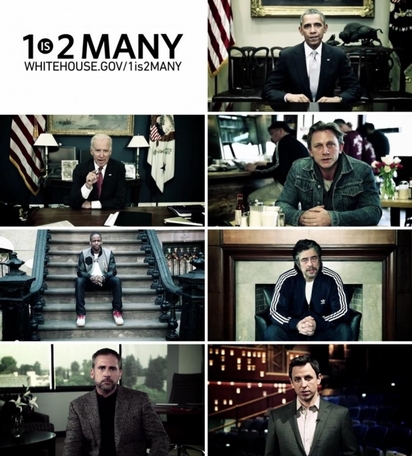 Yes or no? In the context of sexual consent, these words carry great power. However, it is believed that one of these responses is more apt than the other to protect victims of rape and condemn those accused of rape. For years the word “no” has been pivotal to the consent movement surrounding cases of sexual assault, made popular by the saying, "no means no." However, in cases of sexual assault where victims are unable to give consent by saying no, this word falls short of its desired goal. Recognizing these problems, the state of California has taken steps to ensure that victims of rape and assault are protected in cases where they are physically unable to give consent. On Sunday, Sept. 28, California Gov. Jerry Brown officially signed the "Yes Means Yes" bill into law. This bill has been widely debated and faces heavy scrutiny because it challenges the “no means no” ideology. The bill states that in any sexual act both partners need to give consent in the form of a “yes” instead of a"no." The signing of this bill has benefited women by providing a clear definition of consent. The law also clarifies what is considered both sexual misconduct and rape. The “Yes Means Yes” law states, “lack of protest or resistance does not mean consent, nor does silence mean consent.” This clarification and strict definition of rape is expected to have a large impact on the number of sexual assault cases reported at colleges in California. There are numerous individuals affected by this new law because about one in every four college women are said to experience sexual assault. The public relations efforts promoting the signing of the bill specifically targeted college-aged women. Much of the promotion utilized social media and brought key points of the bill to public attention. This promotional strategy spurred conversation in other states about the problems surrounding consent in cases of rape and sexual assault. Targeting the right publics and where they will look for information has allowed this law to be known throughout the United States, connecting all women to a legislative cause that seeks to change more than just language. Public relations teams built off of this law’s momentum and developed the White House’s new public service announcement (PSA),“1 is 2 MANY.” This PSA targets a male audience. The inclusion of male celebrities and leaders speaking out against sexual assault is intended to increase the number of men in support of the “Yes Means Yes” law. The precedence this law has set will not be overlooked thanks to the strategies which have not only spread awareness about the new law, but also the information included in the law and how it can protect both women and men. By Chloe Kasper 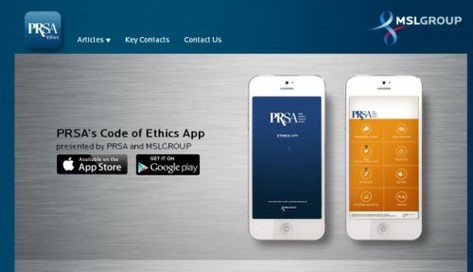 Public relations professionals are now aided in making tough decisions at a speed that keeps up with their ever-changing environment. The Public Relations Society of America (PRSA) has partnered with MLSGROUP to make its code of ethics more accessible by creating a mobile app. This app is all about the PRSA Code of Ethics, which promotes advocacy, honesty and loyalty. The mobile app helps public relations professionals make ethical decisions at the touch of a button. So what’s the big deal? This app proves the public relations industry is advancing with innovative ideas and resources. The convenience of opening an app and receiving instant answers is exactly what public relation professionals need. Also, the principles and guidelines of making ethical decisions will become more apparent to the user. “The app will give professionals at all levels, who are committed to upholding the principles of ethical communications, easy access to real-time guidance to know that what they’re doing is right and, if they face questions, the support they need to justify their counsel,” said PRSA Chair and CEO Mickey G. Nall, APR, Fellow PRSA. Did I mention this app can be downloaded for free in Google’s Android Market and Apple’s App Store? Once you’ve done that, the app features an ethics quiz. Take the quiz and see if your communication ethics are ready for the professional world. Ethics-related posts and updates about new standards that offer guidance on emerging ethics issues are also included. If users have questions about the code of ethics or think some changes are necessary, there is email access to a committee that handles refinements. I highly recommend downloading this app to further educate yourself and understand the importance of ethics. If you find yourself debating if what you are doing is right, the answer can be found right at your fingertips. By Cindy Kirchner |
AboutPRecisely PR is the blog of the Illinois State University Chapter of the PRSSA. We write about Chapter events, the public relations industry, member profiles, and more. Archives
July 2023
CategorIes
All
|
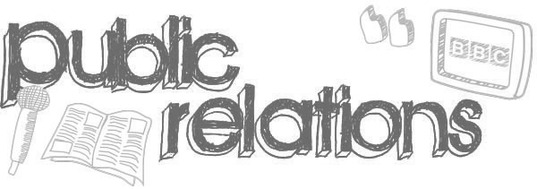
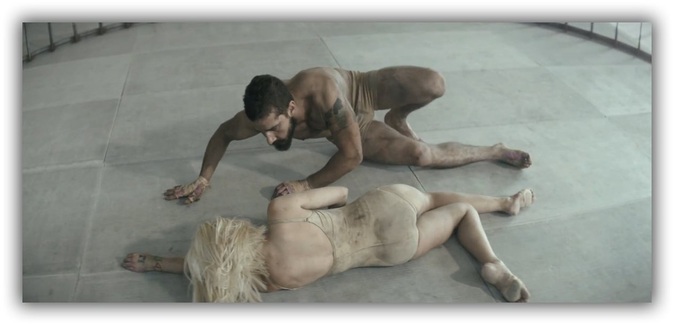
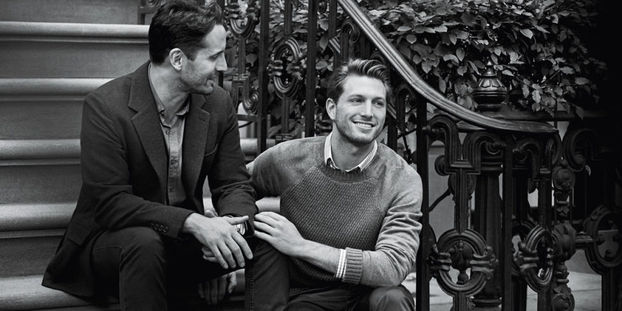
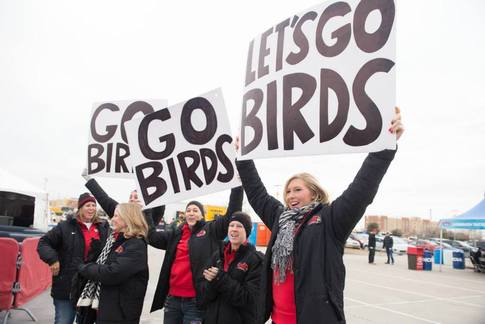
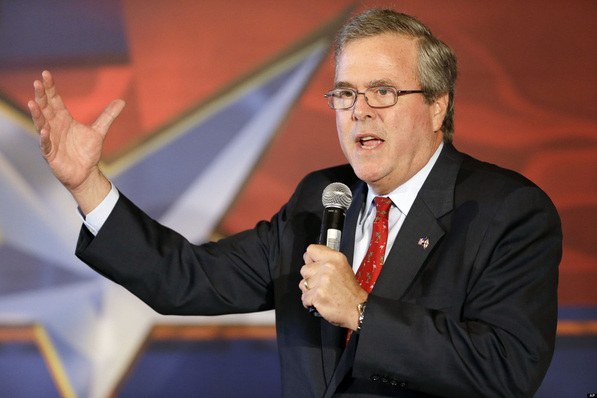
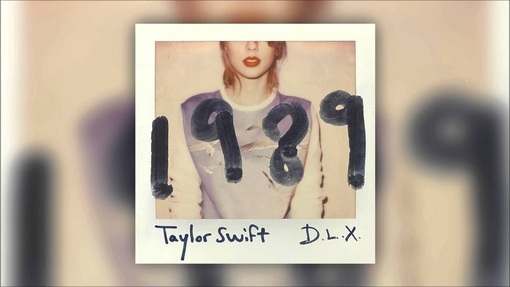
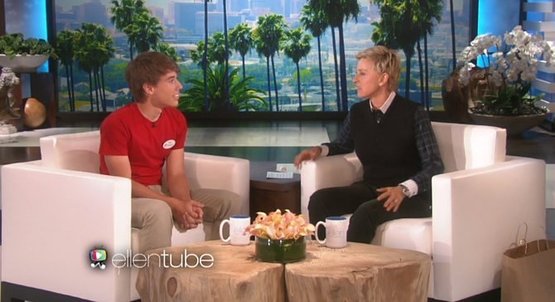
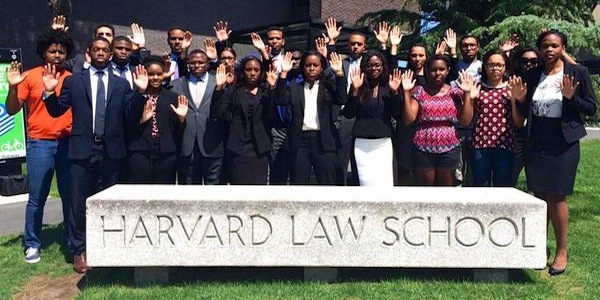
 RSS Feed
RSS Feed
